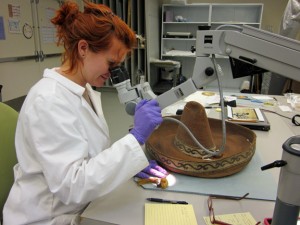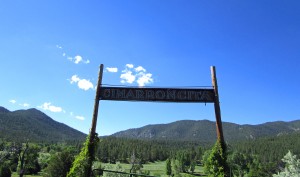 One of the latest artifacts to make its way into the History Museum’s conservation lab: a very well-worn sombrero plucked off the battlefield in Columbus, NM, after Pancho Villa’s raid. Conservation intern Cindy Lee Scott began working on the piece this week, and her efforts show just how different conservation work is from restoration work.
One of the latest artifacts to make its way into the History Museum’s conservation lab: a very well-worn sombrero plucked off the battlefield in Columbus, NM, after Pancho Villa’s raid. Conservation intern Cindy Lee Scott began working on the piece this week, and her efforts show just how different conservation work is from restoration work.
Proof No. 1: If the hat really was part of an infamous battle, then Scott will only clean off the last few years’ worth of dirt.
“If it had been sitting on a battlefield, then that dirt would be part of its history,” she said. “In that case, I will do a minimal cleaning–whatever a low-suction vacuum cleaner can pick up.”
The sombrero was donated to the museum in 2008 by the grandson of a Columbus woman who found it after the raid on her town. It’s relatively simple, with decorations on only the brim and the hatband, and it’s definitely seen better days, with a few holes showing on its brim and near the top. Through her investigation, Scott has already determined that some of what we believed about it isn’t true. For one, it isn’t made of woven straw, but of many tiny braids of straw sewn together. And it might not even be straw, but we’ll have to see whether our equipment can detect a difference between hay, yucca fibers, or some other material. In addition, what appeared to be a leather brim and hatband is in fact a painted woven fabric with leather curlicues stitched onto it.
According to a history of Columbus posted on New Mexico State University’s website, Villa’s raid came suddenly the night of March 9, 1916, as the Mexican Revolution raged to the south. Columbus was “a sleepy little border town,” and about 350 U.S. Army soldiers from the 13th Cavalry were stationed on its outskirts. Despite that seeming defense, Gen. Francisco “Pancho” Villa and up to 600 Mexican revolutionaries stormed into town.
“The Villistas concerned themselves more with raiding than killing, otherwise the town might have been erased. … Alerted by the gunfire and burning buildings, many Columbus residents fled to the desert, or sought refuge in the school house, the Hoover Hotel, or private homes. The noise and fire sealed the fate of the raiding Mexican Army. U.S. Army officers and soldiers, awakened by the commotion, set up a Benet-Mercier machine gun in front of the Hoover Hotel and produced a murderous rain of bullets. Another machine gun set up on East Boundary Street fired north and caught anyone in the intersection of Broadway and East Boundary in a deadly crossfire.”
The fighting lasted from about 4:20 am to dawn, just 90 minutes. In that time, up to 75 Villistas and 18 Americans, most of them civilians, were killed.
The History Museum has a section about the raid in our main exhibit, Telling New Mexico: Stories from Then and Now. Included in it is the clock that was stopped by a bullet and a death mask of Villa, who was stopped by a hail of bullets fired by a band of assassins in 1923.
 While it would be nice to say that Villa once wore the sombrero, we won’t. We can’t prove it. Besides that, it doesn’t say “Hecho in Mexico” or bear any other label that might lead us to a hatmaker or a town of origin. But it could date back as far as 1900, and Scott’s work might put a more definitive date on it.
While it would be nice to say that Villa once wore the sombrero, we won’t. We can’t prove it. Besides that, it doesn’t say “Hecho in Mexico” or bear any other label that might lead us to a hatmaker or a town of origin. But it could date back as far as 1900, and Scott’s work might put a more definitive date on it.
(That’s Scott at left, examining the ornament on the hat’s chinstrap in hopes of determining what kind of threads were used to make it. One possibility: Horse hair.)
Another proof that this is conservation not restoration work is that the hat’s damaged parts likely won’t be repaired. Instead, as any wise conservator will do, the damage will merely be stabilized so it doesn’t get any worse.
And as for this writer’s wise-guy suggestion that the conservators pull some DNA from the sweat that likely once soaked the hatband and throw it into some kind of microfabricated polymeric nanochannel RTPCR mumbo-jumbo device in order to identify its owner, Scott was firm and clear.
“This isn’t TV,” she said. “It doesn’t work like that.”




